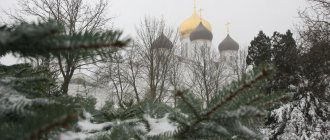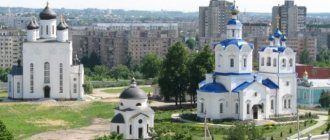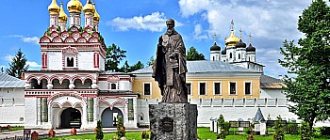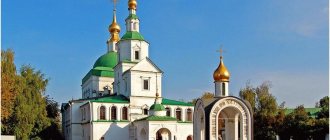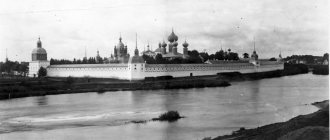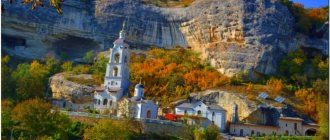Mir
Russia Tula region Novomoskovsk Assumption Novomoskovsky Monastery 54.018173; 38.309482
Russia, Tula region, Novomoskovsk, Parkovy proezd, 6
Novomoskovsk, Tula region
Russia
Telephone:
+7 (48762) 5-42-32, 5-11-87
Holy Dormition Monastery
- Orthodox monastery in the city of Novomoskovsk, Tula region. Founded in 1995 by decree of the Synod of the Russian Orthodox Church. The main shrine of the monastery is the icon of the Mother of God “Seeking the Lost,” painted at the request of the Matrona of Moscow.
History[edit]
The question of opening an Orthodox parish in the city has been worrying the residents of Novomoskovsk for a long time, because believers from this city were forced to travel to churches located in other cities and towns. Many of the parishioners of the Holy Dormition Monastery remember how recently they had to go to Venyov, Obolenka or Epifan for church holidays.
In the 90s, perestroika and changes affected Novomoskovsk. The first Orthodox community was registered here. The rented premises of a former cafe on the outskirts of the city park became the first Orthodox church in the city, which was dedicated to the Feast of the Nativity of the Blessed Virgin Mary, and priest Evgeniy Masyagin was appointed its rector. On December 19, 1992, the first Divine Liturgy was served in the Novomoskovsk church. Soon Hieromonk Laurus (Timokhin) was appointed rector of the temple. The city administration provided the opportunity to buy the premises of the former cafe, and in 1994 the city administration transferred the building of the former Vstrechny cinema to the believers. Thus, another Orthodox church appeared in the city, consecrated in honor of the “Unexpected Joy” icon of the Mother of God. Father Laurus also became its rector and first organizer.
On July 16, 1995, the Holy Synod of the Russian Orthodox Church took place in Moscow, which decided to open the Holy Dormition Monastery in Novomoskovsk. The late Metropolitan of Tula and Belevsky, Serapion, the administrator of the diocese, became the holy archimandrite of the monastery, and his vicar was appointed to be Archimandrite Laurus, who even now bears his responsible obedience, gathering and spiritually caring for the brethren of the young monastery. It was he who carried out the main work on creating a new monastery. Father Laurus's special concern is aimed at strengthening the spiritual life of monks and monks.
In addition to Divine services, economic issues related to the construction and repair of churches, buildings and communications of the monastery are also occupied. In a fairly short time, the Church of the Intercession of the Mother of God appeared with a chapel in honor of the icon of the Mother of God “Seeking the Lost.”
The Assumption Cathedral, the Sunday School building, the bishop's and fraternal buildings were rebuilt. Currently, all this represents a harmonious architectural ensemble that transforms the landscape of the city itself for the better.
Patronal holidays
According to the number of thrones, the monastery celebrates patronal feasts four times a year:
- On February 18, a celebration was established in honor of the icon of the Mother of God “Seeking the Lost”;
- on the third Sunday from Easter the Church celebrates the day of remembrance of the Holy Myrrh-Bearing Women;
- October 14, the day of the Intercession of the Blessed Virgin Mary;
- August 28 is the feast of the Dormition of the Blessed Virgin Mary.
Interesting! The Assumption Monastery in Novomoskovsk annually organizes the Baptism of a large number of believers on the day of remembrance of the holy Equal-to-the-Apostles Prince Vladimir, the baptist of Rus'. It is also customary at the monastery to celebrate the day of the Kazan Icon of the Mother of God in a special way - on November 4, a procession of the cross to the Don River is held here.
Current state[edit]
2 churches were built on the territory - the Church of the Intercession of the Blessed Virgin Mary and the Church of the Assumption of the Blessed Virgin Mary, a summer church in honor of St. Myrrh-Bearing Women and fraternal corps. The main shrine of the monastery is the icon of the Mother of God “Seeking the Lost,” painted at the request of the Matrona of Moscow and the ark with a particle of her relics dedicated by His Holiness Patriarch Alexy II of Moscow and All Rus'.
The brethren of the monastery number about twenty people.
In addition to divine services on the territory of the monastery, the brethren of the monastery carry out divine services in ancient churches, such as: the Church of St. martyr Alexander of Rome in the village of Chentsovo, Zaoksky district, the Holy Kazan Church in the village of Osanovo, the Church of the Nativity of the Virgin in the village of Monastyrshchina and others.
The monastery pays considerable attention to educational activities. There is a Sunday school at the monastery, where adults and children are offered to master the fundamentals of the Orthodox worldview. At the Sunday school there is an Orthodox school of arts, where adults and children are offered to get acquainted with the theoretical and practical foundations of church creativity.
A monastery that became a major district center of the Novomoskovsk deanery? takes care of the spiritual care of the pupils of the city boarding house No. 2 and shows care for everyone who is waiting for the Word of God.
Through the efforts of the brethren of the monastery, divine services are regularly held in the hospital church in honor of the Icon of the Mother of God of Feodorovskaya, which is located at the children's city hospital No. 1. The temple was created on the initiative of the hospital team represented by the chief physician A.I. Raeva with the support of Archimandrite Laurus and was consecrated with the blessing of His Eminence Metropolitan Alexy of Tula and Belevsky in 2006. The chapels of the Holy New Martyrs and Confessors of Russia were opened in the building of the bus station, St. Sergius of Radonezh in correctional school - boarding school No. 2 and in the Novomoskovsk city clinical hospital, where sisters of mercy serve, and you can join them now.
Bakhchisarai miraculous icon of the Mother of God
This ancient Byzantine icon has been in the monastery since the 17th century. It became famous for its miraculous effects during the cholera epidemic in 1848. The icon is also credited with interceding for the city in 1855 and saving it from the Anglo-French squadron. There are other miracle-working icons that are preserved in the records of the Kherson spiritual consistory. At the beginning of the 20th century, the icon of the Mother of God became very dilapidated. The last mention of her fate dates back to 1918. Nowadays, copies of the miraculous icon are kept in the monastery.
Shrines[edit]
Icon of the Mother of God “Seeking the Lost”
- the miraculous icon of the Most Holy Theotokos “Seeking the Lost,” painted with the blessing of the blessed Elder Matrona of Moscow for the Holy Dormition Church in the village of Sebino, of which she was a native.
- an ark with a particle of the relics of the blessed Matrona of Moscow, dedicated by His Holiness Patriarch Alexy II of Moscow and All Rus'.
- numerous particles of the relics of the holy saints of God, including Saints John Chrysostom, Gregory the Theologian, Nicholas the Wonderworker, the great martyr and healer Panteleimon, the martyrs Tatiana and Marina, the blessed prince Alexander Nevsky, St. Peter and Fevronia of Murom, venerable fathers of Kiev-Pechersk, saints of the Vladimir land.
How to get to the Assumption Monastery from Bakhchisarai
The Lavra is located at a distance of about three kilometers from the city of Bakhchisarai. You can travel this distance on foot (for example, the road from the Khan's Palace will take about half an hour, but there are picturesque landscapes along the entire route), but public transport also goes to the monastery.
Bus and minibus number 2 will take you to the Staroselye stop. From here you will need to climb the mountains along an asphalt road for about 600 meters.
If you are traveling to the monastery by car, then follow the signs to Lenin and Rosa Luxemburg streets, and then follow the signs. At the intersection with Basenko Street you will need to turn right, and then, not far from the souvenir market, there is a free parking lot, from which you can climb up the mountains on foot. You can also drive a car almost to the monastery itself, but in this case parking will be paid. You can also use taxi services: Yandex.Taxi, Uber, Gett, Maxim and others.
©
Monastic photo album
Many monasteries stand along the course of the great Russian river Don, and our story is about the very first monastery, since it is located at the very source of the Don in the city of Novomoskovsk.But before we tell about one of the destinies of the Queen of Heaven on earth, it is worth drawing our attention to what monasticism is and what monasteries are needed for.
Monasticism in itself is not a goal, but it is the most powerful means to achieving a higher spiritual life. His goal is to acquire moral spiritual strength for the salvation of the soul. Monasticism is the greatest feat of spiritual service to the world; it protects the world, prays for the world, spiritually nourishes it and intercedes for it, that is, it performs the feat of prayerful intercession for the world.
The main invaluable service of the monks to society lies in the unceasing prayer they perform for the Church, the fatherland, the living and the dead. Egypt is considered the birthplace of monasticism, from there monasticism soon spread to Asia, Palestine and Syria, and then moved to Europe. In Rus', monastic feat began almost simultaneously with the adoption of Christianity. The founders of monasticism in Rus' were St. Anthony and Rev. Theodosius, who lived in the Kiev-Pechersk Monastery. Large monasteries, with several hundred monks, began to be called laurels. Each monastery has its own daily routine, its own rules, that is, its own monastic charter. All monks must necessarily perform various works, which, according to the monastic charter, are called obediences. In contrast to parish churches, in monasteries, ceremonial, complete, and long-lasting priesthood especially flourishes. The Church appears here in all the beauty of its vestments. The Russian people loved monasteries. When a new monastery arose, Russian people began to settle near it, forming a village, which sometimes grew into a large city.
But the history of our monastery began differently. At a time when churches were being closed throughout the country and the history of Russia was being rewritten, 60 kilometers from Tula, on the orders of the party, a Komsomol construction project arose, which resulted in a huge chemical plant and the birth of Stalinogorsk, which later became Novomoskovsk. But life puts everything in its place, and in the city, where until recently there was not a single Orthodox church, a monastery appeared, which turns 15 this year.
The question of opening an Orthodox parish in the city has been worrying the residents of Novomoskovsk for a long time, because believers from this city were forced to travel to churches located in other cities and towns. Many of the parishioners of the Holy Dormition Monastery remember how recently they had to go to Venyov, Obolenka or Epifan for church holidays.
In the 90s, perestroika and changes affected Novomoskovsk. The first Orthodox community was registered here. The rented premises of a former cafe on the outskirts of the city park became the first Orthodox church in the city, which was dedicated to the Feast of the Nativity of the Blessed Virgin Mary, and priest Evgeniy Masyagin was appointed its rector. On December 19, 1992, the first Divine Liturgy was served in the Novomoskovsk church. Soon Hieromonk Laurus (Timokhin) was appointed rector of the temple. The city administration provided the opportunity to buy the premises of the former cafe, and in 1994 the city administration transferred the building of the former Vstrechny cinema to the believers. Thus, another Orthodox church appeared in the city, consecrated in honor of the “Unexpected Joy” icon of the Mother of God. Father Laurus also became its rector and first organizer.
On July 16, 1995, the Holy Synod of the Russian Orthodox Church took place in Moscow, which decided to open the Holy Dormition Monastery in Novomoskovsk. The late Metropolitan of Tula and Belevsky, Serapion, the administrator of the diocese, became the holy archimandrite of the monastery, and his vicar was appointed to be Archimandrite Laurus, who even now bears his responsible obedience, gathering and spiritually caring for the brethren of the young monastery. It was he who carried out the main work on creating a new monastery. Father Laurus's special concern is aimed at strengthening the spiritual life of monks and monks. In addition to Divine services, economic issues related to the construction and repair of churches, buildings and communications of the monastery are also occupied. In a fairly short time, the Church of the Intercession of the Mother of God appeared with a chapel in honor of the icon of the Mother of God “Seeking the Lost.”
The Assumption Cathedral, the Sunday School building, the bishop's and fraternal buildings were rebuilt. Currently, all this represents a harmonious architectural ensemble that transforms the landscape of the city itself for the better.
The brethren of the monastery number about twenty people. In the difficult post-Soviet times, the first of them were hieromonks Elisha (Orekhov), Cyprian (Orlov), Varsanuphiy (Khoroshko). In addition to divine services on the territory of the monastery, the brethren of the monastery carry out divine services in ancient churches, such as: the Church of St. martyr Alexander of Rome in the village of Chentsovo, Zaoksky district, the Holy Kazan Church in the village of Osanovo, the Church of the Nativity of the Virgin in the village of Monastyrshchina and others. The monastery pays considerable attention to educational activities. There is a Sunday school at the monastery, where adults and children are offered to master the fundamentals of the Orthodox worldview. At the Sunday school there is an Orthodox school of arts, where adults and children are offered to get acquainted with the theoretical and practical foundations of church creativity.
Historically, while helping the spiritual needs of their neighbors, monks did not refuse, when they had the opportunity, to serve their temporary needs. At the monasteries there were hospices where monks received, fed and gave rest to wanderers. And now, fulfilling the concept of social service in the Russian Orthodox Church and following the instructions of His Holiness Patriarch Kirill of Moscow and All Rus', the monastery, which has become a large district center of the Novomoskovsk deanery, takes care of the spiritual care of the pupils of the city boarding house No. 2 and takes care of everyone who is waiting Words of God. Through the efforts of the brethren of the monastery, divine services are regularly held in the hospital church in honor of the Icon of the Mother of God of Feodorovskaya, which is located at the children's city hospital No. 1. The temple was created on the initiative of the hospital team represented by the chief physician A.I. Raeva with the support of Archimandrite Laurus and was consecrated with the blessing of His Eminence Metropolitan Alexy of Tula and Belevsky in 2006. The chapels of the Holy New Martyrs and Confessors of Russia were opened in the building of the bus station, St. Sergius of Radonezh in correctional school - boarding school No. 2 and in the Novomoskovsk city clinical hospital, where sisters of mercy serve, and you can join them now.
Through the efforts of the Head of the city of Novomoskovsk E.A. Kozina, who is the chief physician of the Novomoskovsk maternity hospital, has renovated and is preparing to open a chapel in honor of the Icon of the Mother of God “Helper in Childbirth”, in front of which expectant mothers will be able to ask for help and pray.
The main shrine of the Holy Dormition Monastery is the miraculous icon of the Most Holy Theotokos “Seeking the Lost,” painted with the blessing of the blessed Elder Matrona of Moscow for the Holy Dormition Church in the village of Sebino, of which she was a native. Until 1993, the icon was in the above-mentioned church, from where, with the blessing of Bishop Serapion, it was transferred to the then parish Church of the Nativity of the Virgin. Today this shrine attracts believers from all over Russia.
In 1999, in the year of celebrating the 200th anniversary of the Tula diocese, His Holiness Patriarch Alexy II of Moscow and All Rus' solemnly donated a reliquary with a particle of the relics of the newly glorified Matrona of Moscow as a gift to the monastery. The reliquary with a particle of the relics of Matronushka arrived for veneration in the Tver, Vladimir regions, the cities of Saratov and Tomsk, believers of the Republic of Kazakhstan from Baikonur to Alma-Ata had the opportunity to venerate the relics of the blessed one, during worship miraculous healings of believers occurred.
In addition to the above-mentioned shrines, the monastery contains numerous relics of the holy saints of God, including Saints John Chrysostom, Gregory the Theologian, Nicholas the Wonderworker, the Great Martyr and Healer Panteleimon, the Martyrs Tatiana and Marina, the Blessed Prince Alexander Nevsky, St. Peter and Fevronia of Murom, venerable fathers of Kiev-Pechersk, saints of the Vladimir land.
“I will build my church,” says the Lord, “and the gates of hell will not prevail against it” (Matthew 16:18). These words also tell us why Christianity, while going through sometimes terrible godless periods, is able to be reborn. And why, in the city of chemists, power engineers and miners, as Novomoskovsk is called, today, contrary to the original plan, bells can be heard ringing, crosses and domes of Orthodox churches shine. They are not just an aesthetic addition to the overall landscape of the city, they were built at the behest of the hearts of those who live on this land. Our city, despite its small historical age, has already forever imprinted itself on the pages of that Rus', which was called holy. And how could it be otherwise, if all the churches of this city are dedicated to the Mother of God, with whose Name so much is associated in the history of Great Rus'... Residents of the city are also pleased that the monastery in Novomoskovsk is dedicated to the feast of the Dormition of the Blessed Virgin Mary; since ancient times, the most majestic monasteries, main cathedrals and temples of cities were built in the memory of this holy event, for example in Kiev, where Prince Vladimir baptized Rus', the famous Kiev-Pechersk Lavra is called the Assumption Lavra, in the Moscow and Tula Kremlin and the ancient city of Vladimir, the main ones are the Assumption Cathedrals.
Church tradition - this living memory of the Church - testifies that after the burial the disciples of the Lord, the apostles, could not find the Most Pure Virgin in the place that became Her grave. She was taken to the Heavenly Abodes along with her body. And isn’t it gratifying for us to hear about this, because this is evidence that death and evil no longer have their inevitable power and authority over man. And also the day of the Dormition of the Mother of God is the day after which the Blessed Virgin promised never to leave us who remained on earth, and we know that Her prayerful intercession will be the best help for all who hope for salvation.
Monastery architecture
The Holy Dormition Monastery consists of three tiers. At the very bottom is the abbot's house with a bell tower and a chapel with a spring. There are a number of carved out caves that serve as “homes” for pilgrims.
A large stone staircase, lined with granite slabs, leads to the second floor landing. Here begins a narrow staircase that leads to the cave Assumption Church. This is a white stone room, where traces of initial processing remain. On the side of the right wall there are four columns. On the left side there are windows and doorways, and a balcony is also built on this side.
A large painting is carved on the rock - the face of the Mother of God with the Child, who is surrounded by angels and the holy martyrs of Kherson.
Assumption Cathedral
The Assumption Cathedral was founded in 1556, its construction continued until 1560. The cathedral was erected by the best craftsmen of that time - a team of Pskov architects under the leadership of Postnik Yakovlev and Ivan Shirai.
Despite subsequent alterations, today the Pskov style can be discerned in the cathedral. This is a single-domed temple, square in plan. In the 17th century, a brick refectory was added to the western wall of the Assumption Cathedral. And in the 18th century, a new dome in the Ukrainian Baroque style and 12 patterned baroque kokoshniks were added to the cathedral.
Wall paintings from the second half of the 16th - early 17th centuries have been preserved in the Assumption Cathedral. In Russia, only two churches are known with frescoes from the era of Ivan the Terrible that have come down to us. The area of paintings in the Assumption Cathedral is more than a thousand square meters. The composition “Fatherland” is preserved in the dome of the temple, the “Assumption of the Mother of God” is preserved in the altar, as well as the only image in Russia of Ivan the Terrible wearing a crown. One of the rarest frescoes in the whole world is “Saint Christophe”. It depicts the saint as a warrior with the head of a horse, although in the early Christian period he was more often depicted with the head of a dog.
